Contents:
The coin of war represents one of the most painful yet empowering times when each sphere, including numismatics, put effort into victory, however exhausting and fatal this could be. In 1943, the US Mint released one of the most indicative coins of the war, i.e., the 1943 Bronze Lincoln penny.
Why do many collectors strive to obtain this symbol of wartime coinage? What does it look like, and how to identify the coin right away? Let us check.

Briefly About the Story Behind the Bronze 1943 Penny
In 1943, during World War II, the US Mint switched to producing pennies from zinc-coated steel to conserve copper for war purposes. However, a tiny amount of remaining bronze planchets from 1942 were unintentionally fed into the presses, which resulted in the unusual 1943 bronze penny. These coins struck at the Philadelphia, Denver, and San Francisco Mints are honorably called legendary because of their scarcity and circumstances associated with them.
The Appearance of the 1943 Lincoln Bronze Penny
At first glance, the 1943 Lincoln bronze penny closely resembles the common wheat pennies struck between 1909 and 1958. The obverse of the coin, as usual, features the profile of Abraham Lincoln, along with the inscriptions "In God We Trust," "Liberty," and "1943".
The reverse, on its part, displays two wheat stalks that frame the words "One Cent" and "The United States of America," with "E Pluribus Unum" at the top. Nevertheless, the composition and color of the 1943 bronze penny are the main traits that distinguish it from the silver-gray steel version. As for other specifications, it weighs about 3.11 grams, which is heavier than its steel counterpart, with the latter weighing only 2.7.
In the US, there are only three major mint sites located in Philadelphia, Denver, and San Francisco that are responsible for the production of coins. While Philadelphia mint coins have no mint mark, instances produced by Denver and San Francisco mints have a tiny "D" (1943 D bronze penny) or "S" (1943 S bronze penny) respectively, beneath the date on the obverse side. And the presence (or logical absence of a mint mark) identifies how valuable and rare the coin is.
Related article: Top 10 Rare 2 Euro Coins.
1943 Bronze Penny Value
Indeed, the 1943 bronze penny worth is immense. Due to its rarity – there are only ten known examples – it may sell for hundreds of thousands of dollars at auctions, and occasionally even more than $1 million.!The condition of the coin, the mint where it was made, and the authenticity of its composition are some of the factors that affect its worth. All in all, these are overly impressive.
A well-preserved sample from the Philadelphia Mint, for example, was worth $1.7 million, and similarly unbelievable prices have been paid for specimens from Denver and San Francisco. Please do not forget that the market dazzles with counterfeits and altered steel pennies, so pay attention to the certification (such coins should have documents to prove their authenticity).

How to Identify a Genuine 1943 Bronze Penny
Do you wonder how to identify a 1943 bronze penny? In fact, it is quite easy, should you be equipped with the necessary tools and knowledge. So as to authenticate the coin, it is vital to examine it properly. The following are the essential procedures and resources to recognize a real coin:
Check the weight
The weight of a real instance is about 3.11 grams, as we have mentioned before. The 1943 steel pennies, on the other hand, weigh 2.7 grams. This is the first step to take, though. Try to use special numismatic supplies for this step.
Observe the Color
Another obvious trait of a real coin is its shade. Unlike steel varieties, which have a silver-gray appearance, bronze ones have a distinctive reddish-brown color because of their copper-based composition.
Test for Magnetic Properties
Bronze pennies are not magnetic, but steel pennies are. The composition of the coin can be ascertained with the aid of a basic magnet test.
Use Coin ID Scanner
Coin ID Scanner is an innovative device that may identify and authenticate coins with the use of sophisticated technology. All you have to do is scan a coin via the camera of your phone and wait for the system to analyze it. Soon after, you will be redirected to the coin card with its features and current price.
Consult a Professional Grading Service
Finally, you are always free to submit the coin to a professional grading service, such as PCGS or NGC, for the highest level of confidence. They certify the coin's validity and authenticate it using specific methods.
How much is a 1943 bronze penny worth? This is a rather simple question to explore. Anyway, refer to reputable resources and stay up-to-date so as not to miss any updates. Good luck!



